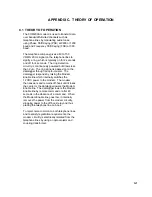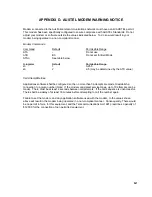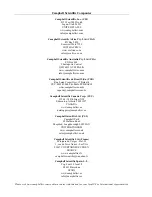
C-1
APPENDIX C. THEORY OF OPERATION
C.1 THEORY OF OPERATION
The COM200A modem is used to transmit data
over bandwidth-limited channels such as
telephone lines by modulating audio tones,
using Phase Shift Keying (PSK) at 9600 or 1200
baud and Frequency Shift Keying (FSK) at 300
baud.
The telephone company gives a 40 to 150
VRMS, 20 Hz signal on the telephone lines to
signify a ring, which is typically on for 2 seconds
and off for 4 seconds. The ring detection
circuitry is continuously powered but draws less
than 2
µ
A. The ring signal is passed on to the
datalogger through an opto-coupler. The
datalogger responds by raising the Modem
Enable line which internally switches the
12 VDC power to the modem. The modem
then answers and remains off-hook until it loses
the carrier or the datalogger lowers the Modem
Enable line. The datalogger lowers the Modem
Enable line by remote command or after 40
seconds in the absence of a command. When
the Modem Enable line goes low, it internally
removes the power from the modem circuitry,
dropping power to the off-hook relay and thus
placing the telephone line on-hook.
To reject noise common to both telephone lines
and to satisfy registration requirements, the
modem circuitry is electrically isolated from the
telephone lines by using an opto-isolator and
coupling transformer.
Summary of Contents for COM200A
Page 4: ...TABLES 1 Dataloggers that Require Direct 12 VDC Connection to COM200A 2 ...
Page 14: ...This is a blank page ...
Page 16: ...This is a blank page ...
Page 18: ...This is a blank page ...
Page 20: ...This is a blank page ...
Page 21: ...This is a blank page ...






































